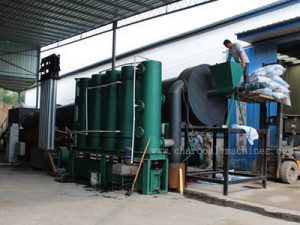Kontinuierliche Karbonisierungsanlage, wenn die Kokosnussschale karbonisiert wird, muss sie zuerst zerkleinert und auf welchen Grad zerkleinert werden. Dies kann nach den Bedürfnissen des Kunden bestimmt werden. Der nächste Schritt ist das Trocknen. Das Trocknen ist ebenfalls sehr wichtig. Das allgemeine karbonisierte Rohmaterial wird karbonisiert. Wenn es trocken ist, sonst ist der Karbonisierungseffekt nicht gut, der Trocknungsgrad der Kokosnussschale beträgt etwa 15 % - 20 % Wasser, es ist nicht zu trocken. Nach dem Trocknen wird es karbonisiert. Es ist auch sehr wichtig. Wenn die Karbonisierung nicht gut beherrscht wird, kann sie aufgegeben, zu Asche verwandelt oder nicht verkohlt werden. Zu diesem Zeitpunkt ist die Verwendung des Karbonisierungsofens sehr wichtig. Wie bedient man ihn? Es gibt mehrere Punkte zu beachten.
1 Die Beschickung des Beschickungsgeräts sollte gemäß dem Materialeinlass der Karbonisierungsmaschine erfolgen. Der fallende Zustand startet und schließt das Beschickungsgerät, um das karbonisierte Material aufzufüllen. Das Material des unteren Beschickungsanschlusses darf sich auch nicht zu sehr ansammeln. Es wird empfohlen, das Material im Karbonisierungsrohr bei etwa 2/3 zu halten.
2 Die Geschwindigkeit der Karbonisierungsmaschine sollte entsprechend dem Karbonisierungseffekt eingestellt werden, und die Spindeldrehzahl sollte richtig eingestellt werden, um die Karbonisausbeute zu gewährleisten. (Die Spindeldrehzahl kann eingestellt werden)
3 Wenn Rauch am Wellensitz an beiden Enden der drehenden Welle austritt, sollte die Dichtungsflanschschraube nach der Schicht rechtzeitig angezogen und gegebenenfalls der Asbestpackungsstreifen des Dichtungsmaterials ersetzt werden.


Wenn man weiß, wie man es bedient, ist der nächste Schritt die Temperaturregelung, der Brenner des Brenners wird eingesprüht, das Karbonisierungsrohr wird erhitzt, das Thermoelement wird in den Feuerraum eingeführt und der Raum im Feuerraum wird auf dem Temperaturregler auf der Tafel des Schaltschranks über das Kabel angezeigt. Temperatur. (Die tatsächliche Temperatur im Karbonisierungsrohr wird 200 ~ 300 Grad höher sein als die gemessene Temperatur im Feuerraum.) Umweltfreundliche Karbonisierungsausrüstung, 15-20 Minuten im Feuerraum erhitzt. Wenn die Temperatur 550-600 Grad erreicht, drücken Sie den Startknopf der Lade maschine, die Schnecke in der Schnecken maschine dreht sich und die Beschickung der Beschickungs maschine beginnt mit der Beschickung. Das karbonisierte Schalenmaterial dreht sich entlang der Spirale der Schnecken maschine. Der Rohr körper klettert das Material zum Beschickungsanschluss oberhalb der Karbonisierungsmaschine.
Wenn das Material aus Kokosnussschalen mit dem Einlass der Karbonisierungsmaschine gefüllt ist, drücken Sie die Starttaste des Karbonisierungsofens, schalten Sie den roten Schalter am elektromagnetischen Regler auf die Position EIN und drehen Sie langsam den Geschwindigkeitsregelknopf, bis der Regler den Ablenkungspfeil anzeigt, was etwa 500-600 U/min (geeignet für Kokosnussschalen) bedeutet. Der Schneckenförderer der Karbonisierungsmaschine wird durch die Spirale gedreht, schiebt das Material nach vorne, rührt es um und bewegt es in den ersten und zweiten Karbonisierungsschläuchen oben und unten. Vor-Trocknung, das Wasser im Niederschlag wird durch das Abluftrohr abgeleitet. Der Schornstein wird in die Luft entlassen, und das Material befindet sich im Rohr. Wenn ein oder zwei Rohre getrocknet sind und in das dritte Rohr gelangen, ist das Wasser abgelagert und gereinigt. Während der Niedertemperaturkarbonisierungsphase, nach kontinuierlichem Vorankommen, Bewegung und Rühren, wenn das vierte Rohr betreten wird, wird das Material gedreht, gerührt, vorangetrieben und über eine Distanz im Hochtemperaturrohrkörper bewegt, um die Karbonisierung von der unteren Temperatur zur hohen Temperatur abzuschließen. Während des Karbonumwandlungsprozesses wird der produzierte Hochtemperaturkohle schließlich durch den Auslass der Karbonisierungsmaschine in den Einlass der wasserjackenartigen Kühl- und Entladeeinheit entladen, und das Hochtemperaturkohle-Pulver des Entladeeinheitrohrs wird durch das Kühlwasser, das den Rohrkörper umgibt, gekühlt und abgekühlt, und schließlich wird der Toner und Ruß nach dem Abkühlen aus dem Entladeeinlass entladen, wie zuvor beschrieben, immer wieder, kontinuierlich arbeitend, um den gesamten Karbonisierungsprozess von Kokosnussschalenprodukten abzuschließen.
